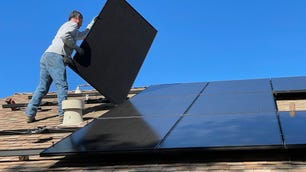Energy generation in the US will grow by 3% in 2024 — and solar power will be the main source of that expansion.
That’s according to the latest report from the Energy Information Administration. The report indicates that, while solar adoption throughout the United States has been steadily increasing in recent years, 2024 could see us approaching a landmark moment for the solar industry.
“In 2025, we expect generation from solar to exceed the contribution from hydroelectricity for the first time in history,” said Joe DeCarolis, administrator of the EIA, in the report’s press release.
Renewable energy has been a focus of federal policy, with assurances being made that solar, wind and hydropower will be made more accessible to all American communities.
With government support and lower and lower costs, solar and renewables will keep growing over the next two years.
The big picture projection
Renewable energy sources are expected to make up 22% of America’s total energy generation capacity by the end of 2024, further increasing to 24% by the end of 2025, according to the EIA. That projection accounts for solar, wind and hydropower.
Those three renewable sources only accounted for 21% of US grid capacity in 2023.
Solar energy is the most rapidly growing renewable energy source by far. The EIA projects that solar generation will increase by up to 41%, building on record setting growth in 2023.
Energy generation from wind will grow 5% and energy generation from hydropower will grow 6% in 2024.
Building on last year’s breakneck solar expansion
There was more solar power added to America’s grid in 2023 than ever before, thanks in large part to federal incentives for solar installations included within the Inflation Reduction Act.
In 2023, over half of the new energy generating capacity in the US came from solar panels — marking the first time in history solar eclipsed 50% of yearly additions to the grid.
The solar industry also had to reckon with some big challenges last year.
High interest rates have made financing solar panels untenable for some people, and some of the largest solar markets in America took a big hit last year — California’s solar installation rate suffered from a massive contraction after the state’s net metering policy was revised to be much more restrictive.
While the federal government has passed favorable legislation, election results may affect how many solar panels are actually installed in the coming years.
Regardless, experts remain cautiously optimistic about the future of solar.
“If we stay the course with our federal clean energy policies, total solar deployment will quadruple over the next 10 years,” said Abigail Ross Hopper, president and CEO of the Solar Energy Industries Association, in the US Solar Market Insight 2023 Year in Review.
How to get rooftop solar for your home
First and foremost, you need to find out if solar is available to you in your living situation.
If you’re a renter, you can’t install your own solar panel system, but expanding community solar programs across the country are being built to support your needs. Homeowners will need to do a little research to make sure that no HOA rules or historical preservation laws will prevent them from setting up their own solar panels.
Homeowners also need to ensure their roof is sound and a good fit for solar.
Reaching out to multiple solar installers is important; make sure to reach out to at least four or five companies to ensure the cost of your solar system is fair. Check reviews from the Better Business Bureau, Google, Yelp and speak to your neighbors who’ve installed solar panel systems.
Finally, make sure you’re taking advantage of every available federal- and state-level solar incentive to make the most of your investment. The Inflation Reduction Act’s 30% residential clean energy credit will stack with any potential state tax credits.
Claiming the federal tax credit is a fairly simple process. The year after your solar installation is completed, fill out and submit IRS Form 5695, Residential Energy Credits when you’re filing your taxes. Your credit reduces the amount of taxes you owe.
The Inflation Reduction Act’s residential clean energy credit applies to solar battery installation as well, and the energy efficient home improvement credit applies to certain furnaces, heat pumps, insulation and more.

















+ There are no comments
Add yours